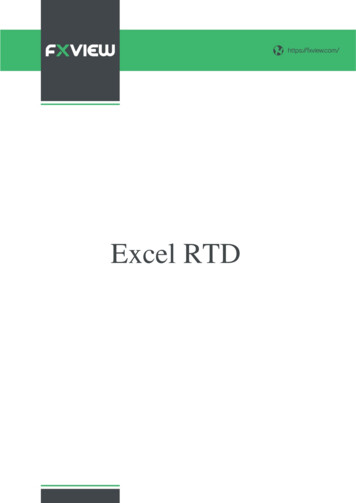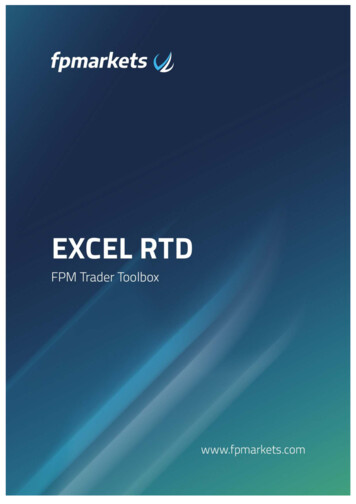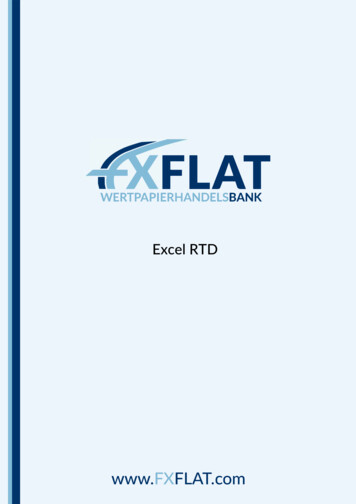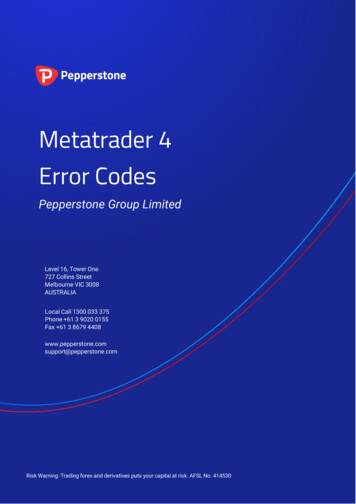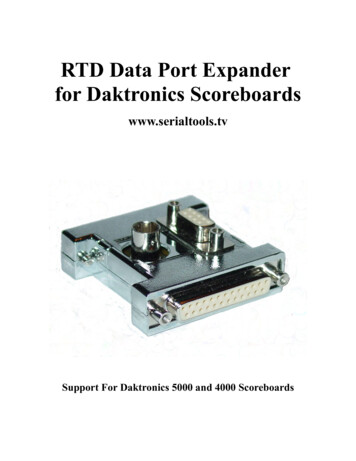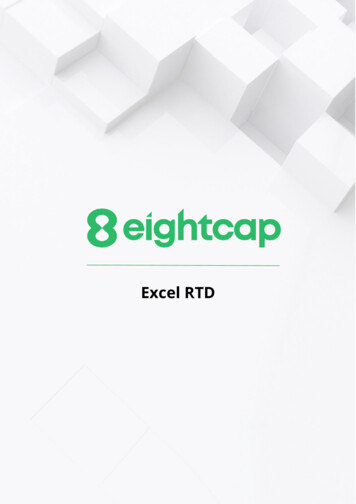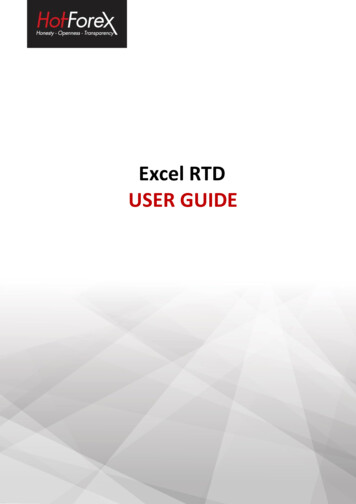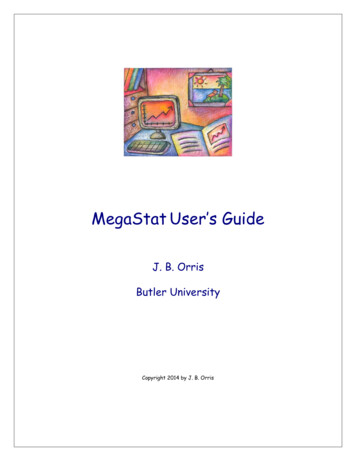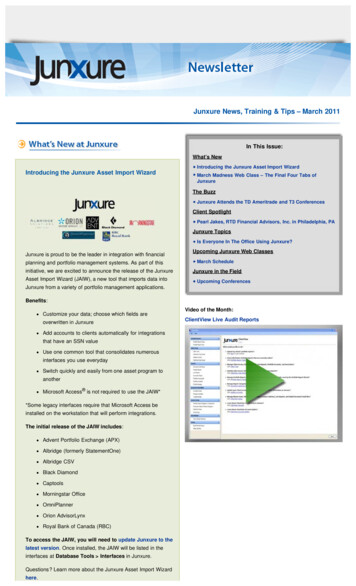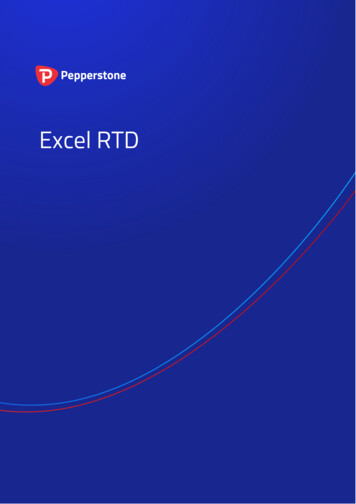
Transcription
Excel RTDRisk Warning: Sed faucibus, quam a pharetra imperdiet, leo est venenatis massa, ac fringilla quam erat sed sapien. Crasvolutpat id eros non congue. Cras non eleifend sem, quis consequat nisl. Maecenas malesuada finibus euismod.Suspendisse id fringilla felis. Proin tristique vulputate enim ac venenatis. Mauris et ante at felis pretium volutpat. Nambibendum lorem ipsum, eget maximus mauris ornare at.
www.pepperstone.comExcel RTD1.About the Excel RTD app . 22Displaying real-time data in Excel . 32.1Running the RTD app . 32.1.13.Available symbols . 32.2Excel formula . 32.3Property names . 42.3.1Account data properties . 42.3.2Price and symbol data properties. 42.3.3Ticket data properties . 52.3.4Bar history . 62.3.5Technical indicators . 82.3.6Other properties . 162.4Symbol names and standardisation . 172.5Ticket volumes . 18Sending trading commands from Excel. 193.1Reading data in VBA code . 193.1.1Checking if a reader is successfully connected . 193.1.2Data consistency across multiple reads . 193.2Sending trading commands from Excel . 203.2.1Differences between trading platforms . 213.2.2Commands and parameters . 213.2.2.1TEST command . 223.2.2.2BUY and SELL commands. 223.2.2.3BUYLIMIT, SELLLIMIT, BUYSTOP, and SELLSTOP commands . 223.2.2.4CLOSE command . 223.2.2.5PARTIALCLOSE command . 233.2.2.6REVERSE command . 233.2.2.7CLOSESYMBOL command . 233.2.2.8CLOSEALL command . 243.2.2.9ORDERSL command . 243.2.2.10ORDERTP command . 243.2.2.11ORDERMODIFY command . 243.2.33.3Standard error messages. 25Asynchronous commands . 25Page 1 of 26
www.pepperstone.com1.Excel RTDAbout the Excel RTD appThe Excel RTD app lets you do two things: Put real-time data into Excel using only Excel’s RTD() function. No macros; noprogramming; no XLL add-insSend simple trading commands from VBA code in ExcelYou can run multiple copies of the Excel RTD app for different accounts, and thencombine the data for those accounts in a single spreadsheet.The app is supplied with an example spreadsheet which lets you enter up to 5account numbers, and then automatically displays a dashboard of equity andbalance etc; symbol prices; and a consolidated list of open positions.Page 2 of 26
www.pepperstone.comExcel RTD2Displaying real-time data in Excel2.1Running the RTD appIn order to put real-time data into Excel you need to run the RTD app. The Excelformulas listed below will give blank values if the app is not running.2.1.1Available symbolsInformation about the following symbols will be available in the Excel RTD app: 2.2MT4/5: the app will report all the symbols which are included in the MT4/5market watchTradable: the app will report all available symbols in the platformAll other platforms: you configure which symbols the app reports using theapp’s Symbols menu.Excel formulaOnce the RTD app is running, you can use the following formula in Excel to insert areal-time feed of account, ticket, or price data. You simply need to fill in the accountnumber, and the “property” which you want to display: RTD("FXBlueLabs.ExcelRTD", , "account number", "property")For example, if your account number is 156734 and you want to display theaccount’s balance, or the bid price of GBPUSD: RTD("FXBlueLabs.ExcelRTD", , "156734", "balance") RTD("FXBlueLabs.ExcelRTD", , "156734", "bidGBPUSD")Please note: with some language settings – for example, Polish – Excel may wantthe sections of the formula to be separate by semi-colons instead of commas. Forexample: RTD("FXBlueLabs.ExcelRTD"; ; "account number"; "property")Page 3 of 26
Excel RTDwww.pepperstone.com2.3Property namesThe RTD app supplies data about the account (e.g. equity and balance), symbolprices, “tickets“, bar history, and technical indicator values. The list of tickets includesboth open positions and pending orders.2.3.1Account data nfreemarginMeaningThe deposit currency of the accountAccount balanceAccount equityFloating profit/lossMargin in useFree marginticketsNumber of “tickets“: open positions and pending orders2.3.2Price and symbol data propertiesThe app supplies the current ask and bid prices for all symbols configured in the app.For example, if the symbol name you are interested in is EURUSD, then the propertyname for its ask price is askEURUSD. For example: RTD("FXBlueLabs.ExcelRTD", , "156734", wSymbolMeaningBid price of symbolAsk price of symbolDaily high of the symbol. Not available on all platforms.The definition of the day’s start (e.g. GMT, or some othertime zone) depends on the broker/platform.Daily low of the symbol. Not available on all platforms. Thedefinition of the day’s start (e.g. GMT, or some other timezone) depends on the broker/platform.The app also provides a count and a list of all configured symbols. For example, thefollowing formulas return the number of available symbols and the name of the 5thsymbol on the list (which can be in any order): RTD("FXBlueLabs.ExcelRTD", , "156734", "symbols")Page 4 of 26
www.pepperstone.comExcel RTD RTD("FXBlueLabs.ExcelRTD", , "156734", "s5")PropertysymbolssN2.3.3MeaningNumber of symbolsName of the nth symbol, e.g. EURUSD. The N value is anindex between 1 and the total number of symbolsTicket data propertiesThe app supplies the following information about each "ticket", i.e. each openposition and pending order. The N value in each property name is an index between1 and the total number of tickets (reported by the tickets property).For example, you can get the symbol name and net profit of the 2nd ticket (if there isone) using the following formulas: RTD("FXBlueLabs.ExcelRTD", , "156734", "t2s") RTD("FXBlueLabs.ExcelRTD", , "156734", NsltNtptNoptNcptNcmMeaningTicket number, i.e. the ID of the open position or pendingorderAction: BUY, SELL, BUYLIMIT, SELLLIMIT, BUYSTOP,SELLSTOPSymbol nameVolumeNet profit (gross profit commission swap). Notapplicable on pending orders, and reported as zero.Gross profit. Not applicable on pending orders, andreported as zero.Swap. Not applicable on pending orders, and reported aszero.Commission. Not applicable on pending orders, andreported as zero.Stop-loss priceTake-profit priceOpen/entry priceCurrent price of symbolOrder commentPage 5 of 26
www.pepperstone.comtNmgtNot2.3.4Excel RTDOrder magic number (MetaTrader 4 only)Open time (as number of seconds since 1/1/1970)Bar historyYou can use the Excel RTD app to request recent price history from the platform. Allvalues are bid prices. (Please note that this price history is not available on thetradable platform.)The property name for bar history is as follows: @bh,symbol,timeframe,data,shift.For example, the following formula shows the high of the current EUR/USD H1 bar: RTD("FXBlueLabs.ExcelRTD", ,"156734", "@bh,EURUSD,H1,high,0")2.3.4.1Timeframe valueThe bar timeframe can either be specified as a number of minutes – e.g. 60 forhourly bars – or you can use standard notations such as H1 or M3. The availabletimeframes are as follows:PeriodM1M2M3M4M5M6M10M12M15Timeframe 6048014402880Page 6 of 26
www.pepperstone.comW1Excel RTD72002.3.4.2Price dataYou can request the following information about each htedMeaningStart time of the bar (in the format yyyy/mm/dd hh:mm:ss)Open priceHigh priceLow priceClose priceRange from high to lowAverage of high and low"Typical" price: average of high, low, and close"Weighted" price: average of high, low, close, and close – i.e.double-weighting on the close valuechangeChange in bar: close minus open, therefore negative for downbars and positive for up bars.abschange Absolute change value, i.e. change converted to a positivenumber if negative2.3.4.3Bar shiftThe final part of the price history formula is the bar "shift", i.e. which bar to getinformation about. Bars are numbered with the newest at zero, and increasing inorder of age. In other words, bar 0 is the current in-progress bar; bar 1 is the lastcomplete bar etc.Therefore, the close price on bar 0 (for any timeframe) is the current bid price. Ineffect, the following two formulas are identical: RTD("FXBlueLabs.ExcelRTD", , "156734", "bidGBPUSD") RTD("FXBlueLabs.ExcelRTD", , "156734", "@bh,GBPUSD,60,close,0")The amount of data available on each timeframe depends on the underlying platform,but will typically be around 250 bars.Page 7 of 26
www.pepperstone.com2.3.5Excel RTDTechnical indicatorsThe Excel RTD app has some built-in indicator calculations which you can requestusing formulas. For example, the following formula will show 14-bar RelativeStrength Index for GBP/USD M5: RTD("FXBlueLabs.ExcelRTD", , "156734", "@rsi,GBPUSD,M5,14,0")Please note that the technical indicators are not available on the tradable platform.The property name for a technical indicator starts with an indicator name such as@rsi or @ema, and is then followed by a list of parameters separated by commas.The first two parameters for an indicator are always the symbol name and thetimeframe, which can be specified either as H2 or as the equivalent number ofminutes such as 120.The last parameter is always the bar "shift". You will normally want to use a value of0 for the shift, in order to get the current indicator value, but you can also use a shiftof e.g. 1 to get the value of the indicator at the end of the previous bar. (The onlyexception are the swing-point indicators, which always return the latest swing pointand do not use a shift parameter.)Many indicators can be applied to different data values from each bar, e.g. the highprice or even the bar range instead of the close price.Please bear in mind that exponential moving averages and similar calculations areaffected by the amount of available bars. For convenience, everyone always refersto the N value in such calculations as "N bars" (e.g. "21-bar EMA"), but this is notwhat it truly means. The N is a weighting factor, and a calculation such as an EMAalways looks at the entire bar history which it has collected, but giving increasedweight to the most recent N bars. Two calculations of an EMA can be different –though only usually by small amounts – if they are using different amounts of barhistory.2.3.5.1@sma – Simple Moving AverageYou can calculate a simple moving average (i.e. arithmetic mean) using the @smaindicator. For example, the following formula does an average of the median pricesfor the last 10 bars on GBP/USD M5:Page 8 of 26
www.pepperstone.comExcel RTD RTD("FXBlueLabs.ExcelRTD", , "156734", "@sma,GBPUSD,M5,median,10,0")The indicator’s parameters are as follows:Parameter MeaningsymbolSymbol name, e.g. GBPUSDtimeframe Bar timeframe, as a number of minutes or a notation such as H1or M3dataData to use from each bar, e.g. close or highperiodNumber of bars to calculate the average overshiftBar shift, e.g. zero in order to get the current value of the indicator2.3.5.2@ema – Exponential Moving AverageYou can calculate an exponential moving average using the @ema indicator. Forexample, the following formula does an average of the ranges of the last 21 bars onGBP/USD D1: RTD("FXBlueLabs.ExcelRTD", , "156734", "@ema,GBPUSD,1440,range,21,0")The indicator’s parameters are as follows:Parameter MeaningsymbolSymbol name, e.g. GBPUSDtimeframe Bar timeframe, as a number of minutes or a notation such as H1or M3dataData to use from each bar, e.g. close or highperiodNumber of bars to calculate the average overshiftBar shift, e.g. zero in order to get the current value of the indicator2.3.5.3@smma – Smoothed Moving AverageYou can calculate a smoothed moving average using the @smma indicator. (Asmoothed average with period N is the same as an exponential moving average withperiod 2N-1).For example, the following formula does an average of the close prices of the last 21bars on GBP/USD H1: RTD("FXBlueLabs.ExcelRTD", , "156734", "@smma,GBPUSD,H1,close,21,0")Page 9 of 26
www.pepperstone.comExcel RTDThe indicator’s parameters are as follows:Parameter MeaningsymbolSymbol name, e.g. GBPUSDtimeframe Bar timeframe, as a number of minutes or a notation such as H1or M3dataData to use from each bar, e.g. close or highperiodNumber of bars to calculate the average overshiftBar shift, e.g. zero in order to get the current value of the indicator2.3.5.4@lwma – Linear-Weighted Moving AverageYou can calculate a linear-weighted moving average using the @lwma indicator. Forexample, the following formula does an average of the ranges of the last 21 bars onGBP/USD D1: RTD("FXBlueLabs.ExcelRTD", , "156734", "@lwma,GBPUSD,1440,range,21,0")The indicator’s parameters are as follows:Parameter MeaningsymbolSymbol name, e.g. GBPUSDtimeframe Bar timeframe, as a number of minutes or a notation such as H1or M3dataData to use from each bar, e.g. close or highperiodNumber of bars to calculate the average overshiftBar shift, e.g. zero in order to get the current value of the indicator2.3.5.5@macd and @macdsig – MACDYou can calculate MACD (the difference between a "fast" EMA and a "slow" EMA)using the @macd indicator. You can also use @macdsig to get the smoothed"signal" value of the MACD indicator.For example, the following formula calculates MACD for GBP/USD M30, using thestandard 12-bar fast EMA and a 26-bar slow EMA, and applying the calculation tothe high price of each bar: RTD("FXBlueLabs.ExcelRTD", , "156734", "@macd,GBPUSD,30,high,12,26,9,0")Page 10 of 26
Excel RTDwww.pepperstone.comThe indicator’s parameters are as follows:Parameter MeaningsymbolSymbol name, e.g. GBPUSDtimeframe Bar timeframe, as a number of minutes or a notation such as H1or M3dataData to use from each bar, e.g. close or highfastNumber of bars for the fast EMAslowNumber of bars for the slow EMAslowingSmoothing period for the signal valueshiftBar shift, e.g. zero in order to get the current value of the indicator2.3.5.6@atr – Average True RangeYou can calculate average true range using the @atr indicator. For example, thefollowing formula calculates the average true range of the last 21 bars on GBP/USDD1: RTD("FXBlueLabs.ExcelRTD", , "156734", "@atr,GBPUSD,D1,21,0")The indicator’s parameters are as follows:Parameter MeaningsymbolSymbol name, e.g. GBPUSDtimeframe Bar timeframe, as a number of minutes or a notation such as H1or M3periodNumber of bars to calculate the average overshiftBar shift, e.g. zero in order to get the current value of the indicator2.3.5.7@rsi – Relative Strength IndexYou can calculate Relative Strength Index using the @rsi indicator. For example, thefollowing formula calculates 14-bar RSI on USD/JPY M3: RTD("FXBlueLabs.ExcelRTD", , "156734", "@atr,USDJPY,3,14,0")The indicator’s parameters are as follows:Parameter MeaningPage 11 of 26
.8Excel RTDSymbol name, e.g. GBPUSDBar timeframe, as a number of minutes or a notation such as H1or M3Number of bars to calculate the indicator overBar shift, e.g. zero in order to get the current value of the indicator@stoch and @stochslow – Stochastic OscillatorYou can calculate the stochastic oscillator using the @stoch indicator. You can alsocalculate the slowed "signal" value for the indicator using @stochslow.For example, the following formula calculates the oscillator on GBP/USD H2 bars,using standard parameters of (5,3,3) – i.e. K period of 5, D period of 5, slowing valueof 3. RTD("FXBlueLabs.ExcelRTD", , "156734", "@stoch,GBPUSD,120,5,3,3,0")The indicator’s parameters are as follows:Parameter MeaningsymbolSymbol name, e.g. GBPUSDtimeframe Bar timeframe, as a number of minutes or a notation such as H1or M3kK period for the calculationdD period for the calculationslowingSlowing period (moving average of D values)shiftBar shift, e.g. zero in order to get the current value of the indicator2.3.5.9@bbupper and @bblower – Bollinger bandsYou can calculate "Bollinger" bands – a simple moving average plus/minus a numberof standard deviations – using the @bbupper and @bblower indicators.For example, the following formula calculates the upper band on GBP/USD M10,using an average of the close prices on the last 30 bars, and 2 standard deviations: RTD("FXBlueLabs.ExcelRTD", , "156734", "@bbupper,GBPUSD,10,close,30,2,0")The indicator’s parameters are as follows:Page 12 of 26
www.pepperstone.comExcel RTDParameter MeaningsymbolSymbol name, e.g. GBPUSDtimeframe Bar timeframe, as a number of minutes or a notation such as H1or M3dataData to use from each bar, e.g. close or highperiodNumber of bars to calculate the indicator overdeviations Number of standard deviations to calculate (e.g. 2)shiftBar shift, e.g. zero in order to get the current value of the indicator2.3.5.10@vol – Volatility (standard deviation)You can calculate volatility – i.e. 1 standard deviation – using the @vol indicator.For example, the following formula calculates the volatility of the last 21 bar-rangeson GBP/USD M10: RTD("FXBlueLabs.ExcelRTD", , "156734", "@vol,GBPUSD,10,range,21,0")The indicator’s parameters are as follows:Parameter MeaningsymbolSymbol name, e.g. GBPUSDtimeframe Bar timeframe, as a number of minutes or a notation such as H1or M3dataData to use from each bar, e.g. close or highperiodNumber of bars to calculate the indicator overshiftBar shift, e.g. zero in order to get the current value of the indicator2.3.5.11@cci – Commodity Channel IndexYou can calculate the Commodity Channel Index using the @cci indicator.For example, the following formula calculates CCI using the typical bar price for thelast 14 bars on EUR/USD H1: RTD("FXBlueLabs.ExcelRTD", , "156734", "@cci,EURUSD,60,typical,14,0")The indicator’s parameters are as follows:Parameter MeaningPage 13 of 26
Excel ft2.3.5.12Symbol name, e.g. GBPUSDBar timeframe, as a number of minutes or a notation such as H1or M3Data to use from each bar. CCI is usually calculated on the"typical" bar priceNumber of bars to calculate the indicator overBar shift, e.g. zero in order to get the current value of the indicator@high – Highest bar valueYou can calculate the highest of a series of bar values using the @high indicator. Forexample, the following formula calculates the highest high during the last 20GBP/USD D1 bars: RTD("FXBlueLabs.ExcelRTD", , "156734", "@high,GBPUSD,D1,high,20,0")The indicator can be applied to any bar data. For example, you can find the highestlow as well as the highest high. You can also use it to find the bar with the largestrange or change.The indicator’s parameters are as follows:Parameter MeaningsymbolSymbol name, e.g. GBPUSDtimeframe Bar timeframe, as a number of minutes or a notation such as H1or M3dataData to use from each bar, e.g. close or highperiodNumber of bars to calculate the indicator overshiftBar shift, e.g. zero in order to get the current value of the indicator2.3.5.13@low – Lowest bar valueYou can calculate the lowest of a series of bar values using the @low indicator. Theindicator can be applied to any bar data. For example, you can find the lowest highas well as the lowest low. You can also use it to find the bar with the smallest rangeor change.The following formula calculates the smallest D1 bar range during the last 20GBP/USD D1 bars:Page 14 of 26
www.pepperstone.comExcel RTD RTD("FXBlueLabs.ExcelRTD", , "156734", "@low,GBPUSD,D1,range,20,0")The indicator’s parameters are as follows:Parameter MeaningsymbolSymbol name, e.g. GBPUSDtimeframe Bar timeframe, as a number of minutes or a notation such as H1or M3dataData to use from each bar, e.g. close or highperiodNumber of bars to calculate the indicator overshiftBar shift, e.g. zero in order to get the current value of the indicator2.3.5.14@swingh and @swingl – Swing points ("fractals")You can calculate the most recent swing points using the @swingh and @swinglindicators. A swing point is defined as a bar with lower highs either side of it (orhigher lows, for @swingl). These swing points are similar to the MT4 "Fractals"indicator.For example, the following formulas finds the most recent swing-high and swing-lowprices on GBP/USD M5, using a 5-bar swing (2 bars either side of swing point) andnot allowing an "unconfirmed" swing involving the current bar: RTD("FXBlueLabs.ExcelRTD", , "156734", "@swingh,GBPUSD,M5,high,2,0") RTD("FXBlueLabs.ExcelRTD", , "156734", "@swingl,GBPUSD,M5,low,2,0")The indicator’s parameters are as follows. Please note that the @swingh and@swingl do not have a bar "shift" parameter; they only return the most recent aningSymbol name, e.g. GBPUSDBar timeframe, as a number of minutes or a notation such as H1or M3Data to use from each bar. You normally use "high" with@swingh, and "low" with @swingl. However, you can use anyvalue; for example, you can use "high" with @swingl to find a barwhich has a lower high than the bars around it.Number of higher/lower bars required either side of the swing bar.The usual value is 2, for a five-bar swing consisting of two lowerPage 15 of 26
www.pepperstone.comExcel RTDhighs/higher lows either side of the swing bar, but you can useany value from 1 (i.e. three-bar swing) upwards.unconfirmed Either 0 or 1. Zero ignores the current bar and only allows"confirmed" swings. 1 includes the current bar, and allows"unconfirmed" swings which can change depending on pricemovements during the current bar.2.3.5.15@keltupper and @keltlower – Keltner channelsYou can calculate Keltner channels using the @kelternupper and @keltnerlowerindicators. A Keltner channel is an exponential moving average plus/minus averagetrue range.For example, the following formula calculates the lower Keltner channel onGBP/USD H1, using a 20-bar EMA minus half of 10-bar ATR: RTD("FXBlueLabs.ExcelRTD", , "156734", "@keltlower,GBPUSD,60,close,20,10,0.5,0")Because Keltner channels are simply a combination of an EMA and ATR, theformula above is equivalent to the following: RTD("FXBlueLabs.ExcelRTD", , "156734", "@ema,GBPUSD,60,close,20,0") –(RTD("FXBlueLabs.ExcelRTD", , "156734", "@atr,GBPUSD,60,10,0") * 0.5)The indicator’s parameters are as follows:Parameter MeaningsymbolSymbol name, e.g. GBPUSDtimeframe Bar timeframe, as a number of minutes or a notation such as H1or M3dataData to use from each bar, e.g. close or high, for calculating theEMAemaPeriod Number of bars to use for the EMAatrPeriodNumber of bars to use for the ATRatrMultiple Multiples of ATR to add to/subtract from the EMAshiftBar shift, e.g. zero in order to get the current value of the indicator2.3.6Other propertiesOther miscellaneous data items provided by the Excel RTD app are as follows:Page 16 of 26
Excel ningTime of the last update from the RTD app. Will report1/1/2000 if the RTD app is not running for the account.Symbol names and standardisationBy default the RTD app uses standardised symbol names. These may be different tothe symbol names which your broker uses in your trading platform. For example,your broker’s symbol names may have a suffix such as cx or mn, e.g. EURUSDcx orEURUSDmn.By default, all forex symbols are converted to the form AAABBB. For example, aname such as EURUSDnm or EUR/USD will be converted by default to EURUSD.You can turn off this standardisation by un-ticking the option "Use standardisedsymbol names" in the app.This setting is intended for spreadsheets where you are collecting data from multipleaccounts on different brokers/platforms (by running multiple copies of the RTD app),and the brokers/platforms use different symbol names.For example, you might have something like the following spreadsheet where thereare account numbers in columns B onwards, and symbol names in rows 2 onwards.You can then have a formula which uses the symbol names in column A withouthaving to adjust for one account using EUR/USD and the other using EURUSDfx etc.A1Symbol/Account2EURUSD3GBPUSDIn cell B2:B12376522C265823654[ see below] RTD("FXBlueLabs.ExcelRTD", , B 1, CONCATENATE("bid", A2))You could then fill the formula from cell B2 into B3, C2 etc and the cell referenceswould automatically adjust.(The CONCATENATE function in Excel simply joins two pieces of together. In theabove example it is joining the text "bid" with the symbol name in column A, toproduce the property name bidEURUSD or bidGBPUSD.)Page 17 of 26
www.pepperstone.com2.5Excel RTDTicket volumesThe RTD app reports the volumes on tickets as the nominal volume, not as a lot size.For example, a size of 0.20 lots will be reported as a volume of 20000.(Unless you are using something like an MT4 mini account with a lot size of 10Kinstead of 100K, in which case 0.20 lots would be 2000 instead of 20000.)Page 18 of 26
www.pepperstone.com3.Excel RTDSending trading commands from ExcelThe RTD app can also be used to send simple trading commands from VBA code inExcel. You can also programmatically read the same data which is available via theRTD function.The following features can in fact be used from any programming language whichsupports COM, not just from VBA in Excel.3.1Reading data in VBA codeYou can read data programmatically using the FXBlueLabs.ExcelReader object. Forexample:Set reader ct ("156734")MsgBox reader.Read("balance")In other words: you create an instance of the FXBlueLabs.ExcelReader object; youuse the Connect() function to link it to a specific account number; and then you canuse the Read() function to get data about the account.The property names for the Read() function are the same as the property names foruse with Excel’s RTD function.3.1.1Checking if a reader is successfully connectedYou can successfully create the ExcelReader object and call the Connect() functioneven if no RTD app is currently running for that account.In order to check whether data is actually available you can use Read() to make surethat properties such as balance are not blank, or you can read the LastUpdateTimeproperty and check that the time is later than 1/1/2000.3.1.2Data consistency across multiple readsIf you are querying multiple pieces of data, particularly multiple pieces of ticket data,then you need to be careful about updates and data consistency. For example,consider the following code which loops through the ticket list:Page 19 of 26
Excel RTDwww.pepperstone.comFor i 1 To reader.Read("tickets")strSymbol reader.Read("t" & i & "s")vVolume reader.Read("t" & i & "v")NextIt is possible for the following to happen: At outset there are 2 open ticketsBetween the two uses of Read(), i.e. between the execution of lines 2 and 3,one of the tickets is closed.Therefore, what used to be ticket 2 becomes ticket 1.As a result, at the end of the first loop, strSymbol will hold the symbol of theticket which is now closed, and vVolume will hold the vol
2 Displaying real-time data in Excel 2.1 Running the RTD app In order to put real-time data into Excel you need to run the RTD app. The Excel formulas listed below will give blank values if the app is not running. 2.1.1 Available symbols Information about the following symbols will be available in the Excel RTD app:
